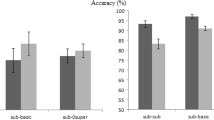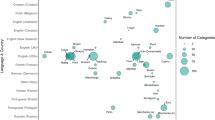Abstract
This paper examines the influence of context on the processing of category names embedded in sentences. The investigation focuses on the nature of information available immediately after such a word is heard as well as on the dynamics of adaptation to context. An on-line method (Cross Modal Lexical Priming) was used to trace how this process unfolds in time. We found that the information available immediately after a category word is presented is not altered by the sentence context in which the word is immersed. Rather, the structure of availability of particular exemplars of the category resembles the typicality structure of a conceptual representation. The adaptation to context occurs later (between 300 and 450 ms after the category word) and takes the form of a rapid reorganization of the structure rather than a gradual activation of a contextually relevant exemplar. We claim that such data is best accounted for in a dynamical framework, where a coherent global structure emerges through locally guided self-organization.
Similar content being viewed by others
References
Anderson R.C., Pichert J.W., Goetz E.T., Schallert D.L., Stevens K.V., Trollip S.R. (1976). Instantiation of general terms. Journal of Verbal Learning & Verbal Behavior 15(6): 667–679
Anderson R.C., Shiffrin Z. (1980). The meaning of words in context. In: Spiro R.J., Bruice B.C., Brewer W.F., (eds). Theoretical issues in reading comprehension. Earlbaum, Hillsdale, NJ, pp. 331–348
Barsalou L.W. (1982). Context-independent and context-dependent information in concepts. Memory and Cognition 20, 82–83
Barsalou L.W. (1983). Ad hoc categories. Memory & Cognition 11(3): 211–227
Barsalou L.W. (1987). The instability of graded structure: Implications for the nature of concepts. In: U. Neisser (eds). Concepts and conceptual development. Cambridge University Press, Cambridge, UK, pp. 101–140
Barwise J., Perry J. (1983). Situations and attitudes. Cambridge, MA, MIT Press
Borsky S., Tuller B., Shapiro L.P. (1998). How to milk a coat: The effects of semantic and acoustic information on phoneme categorization. Journal of the Acoustical Society of America 103, 2670–2676
Bruner J.S. (1973). Beyond the information given: Studies in the psychology of knowing. New York, Norton
Case P., Tuller B., Ding M., Kelso J.A.S. (1995). Evaluation of a dynamical model of speech perception. Perception and Psychophysics 57(7): 977–988
Collins A.M., Quillian M.R. (1969). Retrieval time from semantic memory. Journal of Verbal Learning and Verbal Behavior 8, 240–247
Cree G.S., McRae K., McNorgan C. (1999). An attractor model of lexical conceptual processing: Simulating semantic priming. Cognitive Science 23(3): 371–414
Cussins A. (1990). The connectionist construction of concepts. In: Boden M.A., (eds). The philosophy of artificial intelligence. Oxford readings in philosophy. Oxford University Press, Oxford, pp. 368—440
Duffy S.A., Morris R.K., Rayner K. (1988). Lexical ambiguity and fixation times in reading. Journal of Memory and Language 27, 429–446
Fodor J.A. (1983). Modularity of mind: An essay on faculty psychology. MIT Press, Cambridge, MA
Forster K.I. (1979). Levels of processing and the structure of language processor. In: Cooper W., Walker E., (eds). Sentence processing: Psycholinguistic studies. Earlbaum, Hillsdale, NJ
Forster K.I. (1985). Lexical acquisition and the modular lexicon. Language and Cognitive Processes 1(2): 87–108
Francis W.N., Kucera H. (1982). Frequency analysis of English usage: Lexicon and grammar. Boston, Houghton Mifflin
Fujihara N., Nageishi Y., Koyama S., Nakajima Y. (1998). Electrophysiological evidence for the typicality effect of human cognitive categorization. International Journal of Psychophysiology 29, 65–75
Haken H. (1983). Synergetics, an introduction: Non-equilibrium phase transitions and self-organization in physics, chemistry and biology (3rd edn). Berlin, Springer
Haken H. (1990). Synergetics as a tool for the conceptualization and mathematization of cognition and behavior–How far can we go?. In: Haken H., Stadler M., (eds). Synergetics of cognition. Springer, Berlin, pp. 2—31
Hampton J.A. (1998). Similarity based categorization and fuzziness of natural categories. Cognition 56, 137–165
Hock H., Kelso J.A.S., Schöner G. (1993). Bistability, hysteresis and loss of temporal stability in the perceptual organization of apparent motion. Journal of Experimental Psychology: Human Perception and Performance 19(1): 63–80
Hopfield J.J. (1982). Neural networks and physical systems with emergent collective computational abilities. Proceedings of the National Academy of Sciences USA 81, 6871–6875
Jeka J.J., Kelso J.A.S. (1989). The dynamic approach to coordinated behavior: A tutorial review. In: Wallace S.A., (eds). Perspectives on the coordination of movement. Elsevier Science Publishers B.V, North Holland
Kawamoto A.H. (1993). Nonlinear dynamics in the resolution of lexical ambiguity: A parallel distributed processing account. Journal of Memory and Language 32, 474–516
Kelso J.A.S. (1990). Phase transitions: Foundations of behavior. In: Haken H., Stadler M., (eds). Synergetics of cognition. Springer, Berlin, pp. 249—268
Kelso J.A.S. (1995). Dynamic patterns. MIT press, Cambridge MA
Kelso J.A.S., Case P., Holroyd T., Horvath E., Rączaszek J., Tuller B., Ding M. (1994). Multistability and metastability in perceptual and brain dynamics. In: Kruse P., Stadler M., (eds). Ambiguity in mind and nature. Berlin, Springer-Verlag
Kelso J.A.S., Scholz J.P., Schöner G. (1986). Non-equilibrium phase transitions in coordinated biological motion: Critical fluctuations. Physics Letters A118, 279–284
Knapp, A. G., & Anderson, J.A. Theory of categorization based on distributed memory storage. Journal of Experimental Psychology: Learning, Memory, & Cognition 10(4): 616–637
Łozowski P. (2000). Vagueness in language. Lublin, UMCS Press
MacDonald M.C., Pearlmutter N.J., Seidenberg M.S. (1994). Lexical nature of syntactic ambiguity resolution. Psychological Review 101(4): 676–703
Marslen-Wilson W., Tyler L.K. (1980). The temporal structure of spoken language understanding. Cognition 8, 1–71
Marslen-Wilson W., Tyler L.K. (1987). Against modularity. In: Garfield J.L. (eds). Modularity in knowledge representation and natural-language understanding. MIT Press, Cambridge, MA, pp. 37–62
McEvoy C.L., Nelson D.L. (1982). Category name and instance norms for 106 categories of various sizes. American Journal of Psychology 95, 581–634
McRae K., de Sa V., Seidenberg M.S. (1997). On nature and scope of featural representations of word meaning. Journal of Experimental Psychology: General 126, 99–130
Medin, D. L., & Wattenmaker, W. D. (1987). Category cohesiveness, theories, and cognitive archeology. In U. Neisser (Ed.), Concepts and conceptual development: Ecological and intellectual factors in categorization. Emory symposia in cognition (Vol. 1, pp. 25–62). New York, NY: Cambridge University Press.
Mervis C.B., Rosch E. (1981). Categorization of natural objects. Annual Review of Psychology 32, 89–115
Neely J.H. (1977). Semantic priming and retrieval from lexical memory. Journal of Experimental Psychology: General 106, 226–254
Nicol J., Swinney D., Love T., Hald L. (2006). The on-line study of sentence processing: examination of dual-task paradigms. Journal of Psycholinguistic Research 35(3): 215–231
Onifer W., Swinney D. (1981). Accessing lexical ambiguities during sentence comprehension: Effects of frequency of meaning and contextual bias. Memory and Cognition 9(3): 225–236
Posner M.I., KeeleS.W. (1968). On the genesis of abstract ideas. Journal of Experimental Psychology 77(3): 353–363
Rączaszek J. (1996). A dynamic view of the processing of ambiguous expressions. Polish Psychological Bulletin 27, 189–199
Rączaszek J., Tuller B., Shapiro L.P., Case P., Kelso J.A.S. (1999). Categorization of ambiguous sentences as a function of a changing prosodic parameter: A dynamical approach. Journal of Psycholinguistic Research 28(4): 367–393
Rayner K. (1998). Eye movements in reading and information processing: 20 years of research. Psychological Bulletin 124, 372–422
Rips L.J., Smith E.E., Shoben E.J. (1978). Semantic composition in sentence verification. Journal of Verbal Learning & Verbal Behavior 17(4): 375–401
Rosch E. (1975). Cognitive representations of semantic categories. Journal of Experimental Psychology: General 103, 192–223
Rosch E. (1976). Basic objects in natural categories. Cognitive Psychology 8(3): 382–439
Roth E.M., Shoben E.J. (1983). The effect of context on the structure of categories. Cognitive Psychology 15, 346–378
Rumelhart, D. E., McClelland, J. L., & the PDP Research Group (1986). Parallel distributed processing: Explorations in the microstructure of cognition. Cambridge, MA, MIT Press
Schöner G., Kelso J.A.S. (1988). Dynamic pattern generation in behavioral and neural systems. Science 239, 1513–1520
Schreiber A., Rousset S., Tiberghien G. (1990). Context effects in face recognition: Below response bias. The contribution of a simulation. In: Caverni J.-P., Fabre J.-M., Gonzalez M., (eds). Cognitive biases. Advances in psychology. North-Holland, Amsterdam, Netherlands, pp. 243–274
Seidenberg M.S., Tannenhaus M.K., Leiman J.M., Bienkowski M. (1982). Automatic access of the meanings of ambiguous words in context: Some limitations of knowledge-based processing. Cognitive Psychology 14, 489–537
Shapiro L.P., Hestvik A., Lesan L., Garcia A.R. (2003). Charting the time-course of sentence processing: Evidence for an initial and independent structural analysis. Journal of Memory and Language 49, 1–19
Shapiro L.P., Swinney D.A., Borsky S. (1998). On-line examination of language performance in normal and neurologically-impaired adults. American Journal of Speech-Language Pathology 7, 49–60
Simpson G.B. (1981). Meaning dominance and semantic context in the processing of lexical ambiguity. Journal of Verbal Learning and Verbal Behavior 20, 120–136
Simpson G.B. (1984). Lexical ambiguity and its role in models of word recognition. Psychological Bulletin 96, 316–340
Swaab T., Brown C., Hagoort P. (2003). Understanding words in sentence contexts: The time course of ambiguity resolution. Brain and Language 86, 326–343
Swinney D.A. (1979). Lexical access during sentence comprehension: (Re)consideration of context effects. Journal of Verbal Learning & Verbal Behavior 18(6): 645–659
Swinney D., Osterhout L. (1990). Inference generation during auditory language comprehension. In: Graesser A.C., Bower G.H., (eds). Inference and text comprehension: The psychology of learning and motivation (Vol. 25). San Diego: Academic Press,
Tabor W., Galantucci B., Richardson D. (2003). Effects of merely local syntactic coherence on sentence processing. Journal of Memory and Language 50, 355–370
Tabor W., Hutchins S. (2004). Evidence for self-organized sentence processing: Digging-in effects. Journal of Experimental Psychology: Learning, Memory, and Cognition 30, 431–450
Tabossi P. (1988). Accessing lexical ambiguity in different types of sentential contexts. Journal of Memory and Language 27, 324–340
Tannenhaus M.K., Lucas M.M. (1987). Context effects in lexical processing. Cognition 25, 213–239
Tuller B., Case P., Kelso J.A.S., Ding M. (1994). The nonlinear dynamics of categorical perception. Journal of Experimental Psychology: Human Perception and Performance 20(1):3–16
Tuller B., Kelso J.A.S. (1990). Phase transitions in speech production and their perceptual consequences. In: Jeannerod M., (eds). Attention and performance, XIII. Erlbaum, Hillsdale, NJ, pp. 429–452
Turvey M.T. (1990). Coordination. American Psychologist 45, 938–953
Whitney P. (1986). Processing category terms in context: Instantiations as inferences. Memory and Cognition 14(1): 39–48
Whitney P., Kellas (1984). Processing category terms in context: instantiation and the structure of semantic categories. Journal of Experimental Psychology: Learning, Memory, & Cognition 10: 95–103
Whitney P., McKay T., Kellas G., Emerson W.A. (1985). Semantic activation of noun concepts in context. Journal of Experimental Psychology: Learning, Memory, & Cognition 11(1): 126–135
Widrow, G., & Hoff, M. E. (1960). Adaptive switching circuits. In Institute of Radio Engineers, Western Electronic Show and Convention, Convention Record (Vol. 4, pp. 96–104).
Wittgenstein L. (1953). Philosophical investigations. Oxford, B. Blackwell
Author information
Authors and Affiliations
Corresponding author
Rights and permissions
About this article
Cite this article
Rączaszek-Leonardi, J., Shapiro, L.P., Tuller, B. et al. Activating Basic Category Exemplars in Sentence Contexts: A Dynamical Account. J Psycholinguist Res 37, 87–113 (2008). https://doi.org/10.1007/s10936-007-9061-z
Published:
Issue Date:
DOI: https://doi.org/10.1007/s10936-007-9061-z




